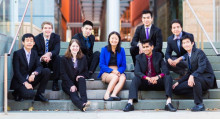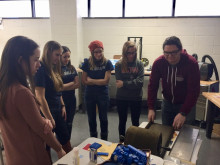Karen A Reiman-Sendi
Posts tagged with engaged learning
Showing 1 - 8 of 8 items

Collaboration with students on library assessment projects is rewarding, both for the student and for the library. Student learning is front and center during any assessment project where the student is involved as a fully engaged team member. This post shares some thoughts about teaming up with students on assessment efforts.

Project Alivio is a multidisciplinary global health project team that is a part of Michigan Health Engineered for All Lives (M-HEAL). Our goal is to reduce the incidence rate of pressure ulcers in San Juan de Dios hospital. What makes us unique as a project team is that our 19 students work as a co-design team with the Students Association of International Medical Research (SAIMER), a medical student organization from the Universidad de San Carlos in Guatemala City. As we design our solution, we are constantly receiving input from peers our age with more medical experience at our target location.
Pressure ulcers, or bedsores, form when a patient is exposed to pressure for a prolonged period of time. This pressure restricts proper blood flow to a certain area on the body, usually the coccyx, heels, back of head, or elbows, causing skin and tissue damage. To prevent pressure ulcers, nurses turn patients to offload the pressure exerted on the body. Pressure ulcers have high incidence rates in Guatemala City for many reasons, but the factor we are targeting is the understaffing of nurses.
Our team meets for several hours a week to design, build, discuss progress, and plan next steps. With the input of professors, physicians, and nurses from both universities, we hope to design a sustainable solution for our end-users. We also value offering our members a meaningful and educational project experience.
This spring, from April 29th to May 10th, seven of our members will be traveling to Antigua, Guatemala. In past, we have made two trips to Guatemala to conduct a needs assessment, which is how we narrowed the need to pressure ulcer prevention. This will be the first trip that is focused on the design itself. We will bring some sketches and prototypes of different concepts to show to our stakeholders to receive feedback. Besides the project itself, the trip will be a great opportunity for some of our newer members to learn more about the global health scene and feel connected to this project.
Pressure ulcers, or bedsores, form when a patient is exposed to pressure for a prolonged period of time. This pressure restricts proper blood flow to a certain area on the body, usually the coccyx, heels, back of head, or elbows, causing skin and tissue damage. To prevent pressure ulcers, nurses turn patients to offload the pressure exerted on the body. Pressure ulcers have high incidence rates in Guatemala City for many reasons, but the factor we are targeting is the understaffing of nurses.
Our team meets for several hours a week to design, build, discuss progress, and plan next steps. With the input of professors, physicians, and nurses from both universities, we hope to design a sustainable solution for our end-users. We also value offering our members a meaningful and educational project experience.
This spring, from April 29th to May 10th, seven of our members will be traveling to Antigua, Guatemala. In past, we have made two trips to Guatemala to conduct a needs assessment, which is how we narrowed the need to pressure ulcer prevention. This will be the first trip that is focused on the design itself. We will bring some sketches and prototypes of different concepts to show to our stakeholders to receive feedback. Besides the project itself, the trip will be a great opportunity for some of our newer members to learn more about the global health scene and feel connected to this project.

The BLUElab NicarAGUA team, in partnership with FNE International, has been collaborating with the El Jicaral, Nicaragua community since September 2015. Since that time, three in-country trips have been conducted. First, in 2016, a preliminary needs assessment trip was conducted in the surrounding communities. Through extensive surveys and interviews with members of communities visited, it was determined that the greatest need of this community was access to water during the dry season.

Perch’s mission is to make research more accessible to undergraduates.
UROP, the Undergraduate Research Opportunity Program, does a great job at its mission: helping underrepresented and first-generation students gain their first research experience and make the most of it. When UROP started 25 years ago, it was able to accommodate every eligible student who applied.That’s no longer true. The number of undergraduates seeking research experience has grown tremendously in the last decade. Why?
For many students, undergraduate research is their first experience working on real-world problems that may provide widespread impact and help people in the future. Through research, students gain valuable critical thinking skills, a new way of asking questions. Research is a chance for students to apply what they’ve learned in class to the real world, to venture boldly beyond the maps of the known. Research is a chance to improve people’s lives, it’s the chance to get a law of nature named after you, it’s the universe trying to understand itself. Not to mention that undergraduate research experience is now necessary rather than an added bonus when applying to graduate school, industrial R&D jobs, and numerous other career paths.
UROP, the Undergraduate Research Opportunity Program, does a great job at its mission: helping underrepresented and first-generation students gain their first research experience and make the most of it. When UROP started 25 years ago, it was able to accommodate every eligible student who applied.That’s no longer true. The number of undergraduates seeking research experience has grown tremendously in the last decade. Why?
For many students, undergraduate research is their first experience working on real-world problems that may provide widespread impact and help people in the future. Through research, students gain valuable critical thinking skills, a new way of asking questions. Research is a chance for students to apply what they’ve learned in class to the real world, to venture boldly beyond the maps of the known. Research is a chance to improve people’s lives, it’s the chance to get a law of nature named after you, it’s the universe trying to understand itself. Not to mention that undergraduate research experience is now necessary rather than an added bonus when applying to graduate school, industrial R&D jobs, and numerous other career paths.

The library is more than a place to read, study, or research. As the Graduate Intern for the Library Student Engagement Program I have found that library to be a place that stimulates creativity, fosters self-efficacy, and even creates a bit of fun. To me, the library has become a place for growth, where engaged learning is not merely in a classroom, but also in the place that prepares students for the classroom. As the program assistant for the Library Student Engagement Ambassadors, I see this transformative learning firsthand, and even better, I experience it alongside the students I mentor.

This past week, the Michigan Library Engagement Ambassadors went to the Hamilton Crossing Community Center for their Family Reading Night event.

Starting last October, I worked as the University of Michigan Library Student Engagement Ambassador. With six other wonderful ambassadors, we aimed to actively publicize library resources and services to the campus community through events and social media. We functioned in two different teams: the programming team focused on creating and planning events while the social media team concentrated on publicizing by making posts on Facebook and Twitter. The system was flexible enough to chime in and share ideas on both parts through our whole group meetings. I soon noticed that viewing the library from a student’s perspective could be effective.

Insider view of the Shapiro Design Lab from the Library Student Engagement Ambassadors. The Ambassadors had the fantastic opportunity to tour the Shapiro Design Lab and find out all about what different facilities and capabilities they have there. We even got to try out some of the equipment, which was pretty cool!